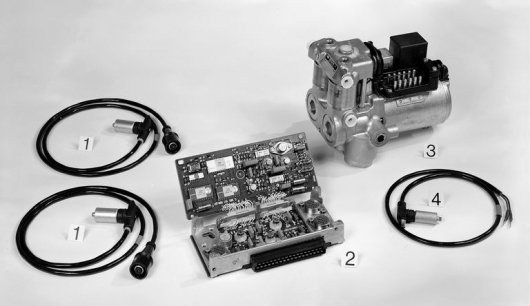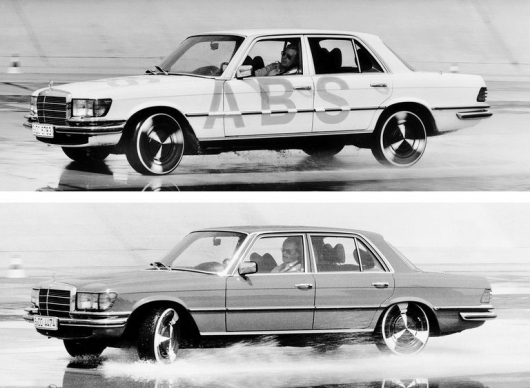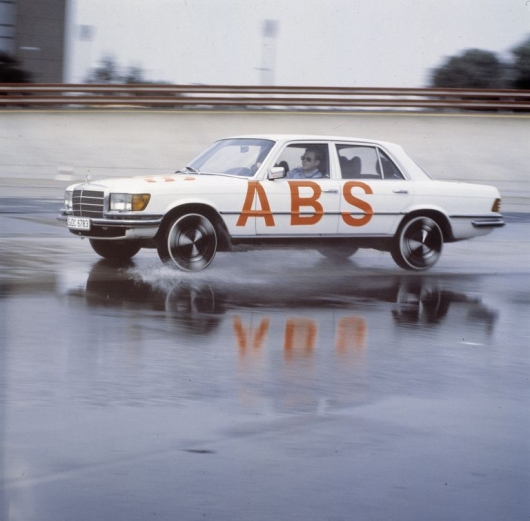Here’s how 40 years ago was invented the anti-lock brake system
Serial anti-lock braking system ABS 40 years old

Did you know that the developer of the anti-lock brake system (ABS) was Mercedes-Benz? 40 years ago, in 1978, outside the gates of the German plant for the first time drove a car equipped with technology, without which we cannot imagine any modern passenger car. Thus began the greatest revolution in the fight for the safety of the vehicles. Here’s how it happened.
Introduction in 1978, anti-lock braking systems forever changed the meaning of safe movement by car. It was not only the first global innovation, which could help you avoid an accident, but this, unprepossessing at first glance, the technology that opened the door for modern systems the performance and safety of vehicles that we enjoy today. The amazing thing is that the idea itself is ABS technology was not new when Bosch and Daimler finally fixed it in a stock car in the late 70-ies. How grow “legs” technology, let’s put a little deeper.

The first stage in the development of ABS (start)
Before the Second world war French and German engineers (including Robert Bosch) experimented with many anti-skid systems for railway and aviation industries. It was the first attempt, failed to bring practical results, but they helped create a road map for action, outlined the General trends of development and the foundations for future technology.
The yard was in 1936. The experiments were carried out mainly in the planes with double landing gear in the front that are “sick” one structural condition which could cause damage to the propeller and/or motor – if you lock the wheels on a dirt runway (runway), the aircraft can roll over.
The second stage of the ABS
In the postwar years, in 50 years a pioneer in the mass adoption of disc brakes, Dunlop based on early basic research invented their own system to improve braking efficiency. The improvement in braking was 30%.
The idea was picked up by other British companies. Thus appeared the first prototypes of the brake system Maxaret Anti-Lock System. By the way, initially, the technology was also designed for aviation, but fast enough it was adapted for cars. In 1952 the system was installed on the car 6 Morris, and closer to the early 60, in 1958, the forerunner of ABS appeared on the Jaguar equipped with disc brakes with the participation of Dunlop. The stress has changed solely on the front wheels, and the system combines elements of the mechanical-hydraulic framework.
The amazing thing is that the technology was compact enough, no wonder the next vehicle after airplanes and cars where put “antiblockiersystem” brakes was bikes. It was of course a prototype, but it’s nice to realize that the engineers never forgot about safety on motorcycles, despite the late appearance of ABS on two-wheeled transport.
In the 60-ies of the Ferguson Research used it in the world’s first four-wheel drive Formula One car, the Ferguson P99 model.

The third stage of development (the British failed to jump above the head)
When Concorde was developed by ultra-modern anti-lock braking system with electronic control, it seemed that the British have reached the pinnacle of technology. However there was one small but important “but”. But while cost was not a problem when you develop the most expensive plane in the world, the challenge of making ABS is cheap and reliable enough for mass automotive production sector was not executed by the British.
The fourth stage of development (parallel to the German approach)
In parallel, the research started (also in the early 50’s, in 1953) at Daimler.It all began with the moment when Hans Sheinberg, the then head of design Mercedes-Benz filed a patent application on the system, prevent wheel lock of the vehicle during heavy braking. The problem was that in comparison with aviation and Railways of the car required more sensors and faster processing of signals. Required components necessary for the registration of acceleration and deceleration of rotation of the wheels without mistakes, including when cornering, on uneven surfaces and in harsh conditions.
Ten years later the first part of the research was completed and in 1963, Daimler-Benz began work on its first electro-hydraulic brake control system. In 1966 the company started cooperation with the “Heidelberg electronics specialist Teldix”, which later came under the General brand Bosch. Premiere pre-production version took place in 1970, when Hans Sherenberg introduced analog-electronic anti-lock system “Mercedes-Benz/Teldix” for the media in those years, releasing on the test track in Untertürkheim your concept.
But this research was never finished. For mass production and predictable experience required digital controller (in a way, the simplest computing machine). According to the engineer jürgen Paul, project Manager of the “ABS” Mercedes-Benz, the decision to use digital microelectronics for the second generation systems was a breakthrough in the development of the automotive ABS.
Sudden disturbances, such as uncontrolled rotation and lack of reaction of the car turning the steering wheel during braking have less to worry about buyers of Mercedes-Benz S-Class. While Mercedes used the slogan: “engineered like no other car in the world”, and in this case, the first ABS system on a production car, it really was not just a beautiful slogan.
When Mercedes-Benz and Bosch introduced the production-ready technology on test track for Daimler in August 1978, in their brochure stated the following:
“Anti-lock brake system uses a computer to control the change of rotation speed of each wheel during braking. If the speed slows too fast (for example, when braking on a slippery surface) and the wheel has a risk of locking, the computer automatically reduces the braking pressure. The wheel again accelerates, brake pressure is again increased, thereby braking the wheel. This process is repeated several times in a matter of seconds”.

Nothing reminds you of such a description? Perhaps at the moment the German marketers could not predict that four decades later, every new car sold in the world from Vesta to the Senna McLaren will have a huge chunk of their capabilities in safety and prevention of accidents modern generation of the first anti-lock braking system…
You may not have thought about it, but the ABS provides us with the most important form of torque vectoring and also gives us the ability to control during braking. The system also allows manufacturers to configure several driving modes, which provide different degrees of slip of tires, ranging from nearly minimum to maximum impact of assistance on the road during braking.
Working together with aerodynamic tuning and monstrously powerful carbon brakes, the ABS can create ridiculously short braking distances on modern cars, easy to work on huge, heavy and powerful machines. Sensors and a processor processing the data coming from the ABS also make it possible to track and control cravings and stabilize any vehicle in almost all weather conditions and situations.
Of course, smart diffs, good tyres and working Aerobus also play a huge role, but most of the data sent in a digital brain these sensors back to the ABS controller, one million times per second. Whether in the car, plane or an old experimental bus that somehow ended up on the ice at the site Mercedes-Benz:
